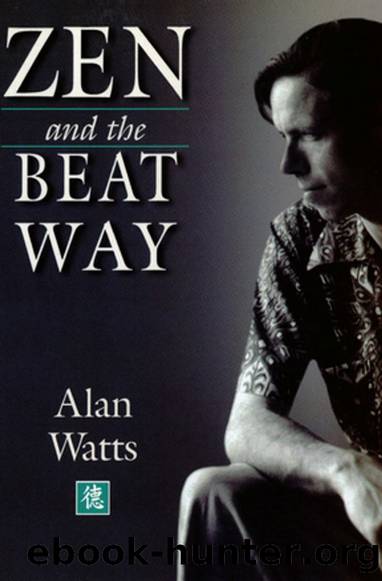Zen and the Beat Way by Alan Watts

Author:Alan Watts [Watts, Alan]
Language: eng
Format: epub
ISBN: 9781462904662
Barnesnoble:
Publisher: Tuttle Publishing
Published: 0101-01-01T00:00:00+00:00
C H A P T E R F I V E
The Democratization of Buddhism
So then, out of this kind of appreciation, born of stillness and a delight in seeing how nature takes its course, came the entire cult of Zen art, with its special kind of primitivity, its special ceramics, its special calligraphic styles, and its special gardens-all of which are manifestations of âthe controlled accident.â
Consider this water jar. The bottom has been left unglazed. But look, see how the glaze has been allowed to run. Its not at all what we would call neat. I have watched a man pick up an unpainted plate and, as he applies the glaze, just go whoosh once with the brush-and its done. There is another man who glazes by wood smoke, and he may put as many as eleven hundred pieces in his kiln. He wraps each piece in straw, and wherever the straw touches, it leaves a splash of orange against a purple background. The straw arranges itself according to the nature of straw. It doesnât follow strict human direction. And when he opens up the kiln and brings the things out, he looks eagerly to see what the straw has done.
This principle of letting glaze run to see what happens is wu wei. It is noninterference. This is mushin also: no-purpose. It can also be translated as âno specific intent.â And, of course, sometimes this noninterference doesnât work. The master picks up the plate or bowl and says, âThis is not very interesting,â and rejects it.
What then are the canons of taste that decide whether he accepts one of these accidents or rejects it? Because here an additional principle of control enters. In the practice of calligraphy, for instance, a man may sit down with a huge pile of paper in front of him and do piece after piece after piece, and if it isnât just right, he throws it away. Eventually he finds one that is just right.
There is a famous story of a Zen master who was doing calligraphy and had a very smart monk who was his assistant standing beside him. And the monk said, âUh-uh,â to each one the master did. âYou could do better than that.â And âOh, no, no, come now, you know you can do much better than that.â His master got more and more furious, and when the monk had to go out to the benjo-to the toilet-he thought, âQuick, while he is away. ⦠â And he did another piece. When the monk came back and looked at it, he said, âA masterpiece.â
So what determines this element of selection? How do you know which drawing or bowl or plate to choose? Take another example. There was a tea caddy, made out of clay, and when Sanu Riku was having tea ceremony, he saw this tea caddy and made no comment on it. And the owner was so disappointed that he smashed it. But one of his friends picked the broken pieces out of the trash can and took them to a mender, saying, âLook, mend this with gold.
Download
This site does not store any files on its server. We only index and link to content provided by other sites. Please contact the content providers to delete copyright contents if any and email us, we'll remove relevant links or contents immediately.
The Way of Zen by Alan W. Watts(6292)
Ego Is the Enemy by Ryan Holiday(4967)
The Art of Happiness by The Dalai Lama(3851)
The Book of Joy by Dalai Lama(3709)
Why Buddhism is True by Robert Wright(3291)
Spark Joy by Marie Kondo(3091)
Shift into Freedom by Loch Kelly(3033)
Happiness by Matthieu Ricard(2890)
A Monk's Guide to a Clean House and Mind by Shoukei Matsumoto(2787)
The Lost Art of Good Conversation by Sakyong Mipham(2444)
The Meaning of the Library by unknow(2395)
The Third Eye by T. Lobsang Rampa(2175)
The Unfettered Mind: Writings from a Zen Master to a Master Swordsman by Takuan Soho(2161)
Red Shambhala by Andrei Znamenski(2074)
Anthology by T J(2049)
The Diamond Cutter by Geshe Michael Roach(1957)
Thoughts Without A Thinker: Psychotherapy from a Buddhist Perspective by Epstein Mark(1901)
Advice Not Given by Mark Epstein(1767)
Twilight of Idols and Anti-Christ by Friedrich Nietzsche(1764)
